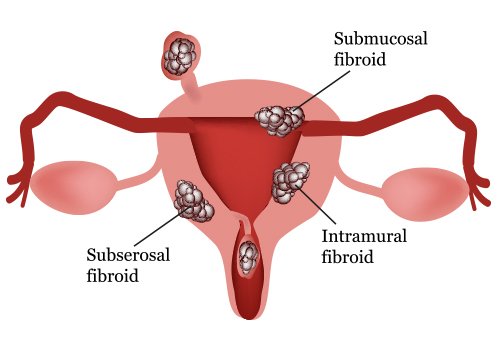Millions of women worldwide struggle with uterine fibroids, and have gone on to successfully receive treatment. If you were just diagnosed with fibroids, or suspect you may have one, don’t panic! Here’s what you need to know.
What Exactly Are Uterine Fibroids?
A uterine fibroid, also know as a leiomyoma or myoma, is a benign (non-cancerous) mass of muscle and connective tissue found inside, or just outside, the uterus. A fibroid’s size can range widely, from the size of a seed or smaller to – in extreme cases – the size of a grapefruit. Uterine fibroids are extremely common, with 20 to 80 percent of women developing fibroids by the time they reach 50.
Where To Find Uterine Fibroids
Fibroids classify into to three types, depending on the location they’re found in or near the uterus:

- Subserosal uterine fibroids form outside the uterus and protrude inward, causing prolonged and heavy bleeding, and even anemia.
- Submucosal uterine fibroids, while not as common as other types of fibroids, grow just beneath the surface of the uterus lining and protrude outward. These fibroids are less likely to impact your menstrual cycle, but may cause back pain or bladder pressure.
What Causes Uterine Fibroids?
The cause of uterine fibroids are still unclear. However, it’s been documented that fibroids are likely associated with a high level of estrogen, and potentially family genetics. Uterine fibroids don’t develop until a women’s reproductive years and disappears or shrinks during menopause when estrogen levels decrease.
Additionally, African-American women, frequent red meat eaters, and women who are overweight are considered to be at higher risk.
Common Symptoms of Uterine Fibroids
The most frequent uterine fibroid symptoms women experience are:
- Pelvic pain and pressure, including pain during intercourse
- Feeling of fullness or bloating in the lower abdomen
- Need to urinate more frequently
- Weight gain
- Constipation
- Reproductive issues, including possible infertility
Most women who develop fibroids don’t have any symptoms since they’re small enough to go without noticing them.
However, if you suspect you may have a fibroid, make sure to visit your health provider. An annual pelvic exam can detect and diagnosie if one has fibroids. Other methods of diagnosis may be need an ultrasound, MRI, or hysteroscopy.
Uterine Fibroid Treatment Options
The good news, is that if you have a fibroid causing symptoms, there are a number of fibroid treatment options available. The size and location of the fibroid(s), as well as your age and desire to bear children, determines the best treatment options available.
Medication can cause them to shrink from blocking the production and secretion of estrogen. Low-dose birth control, for instance, can be be prescribed to control symptoms of fibroids, like heavy menstrual bleeding and pelvic pain.
Other medications to treat fibroids include “gonadotropin releasing hormone agonists” (GnRHA), such as Lupron®. GnRHA can help make fibroids easier to remove, or provide temporary relief of symptoms, but are also known to have side effects including decreasing sex drive, hot flashes, and depression.
In more extreme cases, you may require surgery, with the type of surgery depending on the location of the fibroid. There are also non-surgical ways to eliminate fibroids.
Invasive Surgical Procedures
Hysterectomy
A hysterectomy is the removal of the uterus or full female reproductive system, which should only be done when you no longer desire to become pregnant. Fibroids account for nearly one-half of hysterectomies performed annually in the United States. While effective in removing fibroids, this is a major operation and has a 30 percent complication rate. Before you jump into getting a hysterectomy, make sure you get a second opinion since there are several alternative options available that aren’t nearly as intrusive. Recovery time from a hysterectomy takes several weeks.
Myomectomy
Unlike the hysterectomy, which removes the entire uterus, the myomectomy is a surgical procedure to only remove the fibroids. This procedure is a good option for women who still want to have children, however there are risks involved since this is still considered an invasive surgery. Complications can include blood loss, uterine scaring that impairs fertility, and a higher chance of fibroid regrowth.
Alternative To Surgery
Uterine Fibroid Embolization (UFE)
Uterine fibroid embolization is a much less invasive technique compared to a hysterectomy, and has a higher success rate than myomectomies.
During a uterine fibroid embolization, a small incision (the size of a dot) is made on your upper thigh and a tiny tube is inserted through the incision into the femoral artery. A trained physician locates the blood supply to the fibroid, which is then blocked by plastic or gel particles injected into the blood vessels. Without a steady blood supply, the fibroids begin to shrink.
This non-surgical, out-patient procedure typically lasts under an hour and is performed under local anesthetic and sedation. Patients undering UFE are back at work in a few days, instead of weeks. The procedure also has a very high success rate, with 94 percent of all UFE patients experiencing relief from fibroid symptoms and significant fibroid shrinkage.
Understand Your Options
If fibroids are affecting your daily life, it makes sense to seek medical professional treatment. But remember, invasive procedures, such as a hysterectomy, should be the very last resort to treating fibroids.
If you would like to learn more about nonsurgical treatment for fibroids, call us at (866) 479-1523 to set up a free consultation.